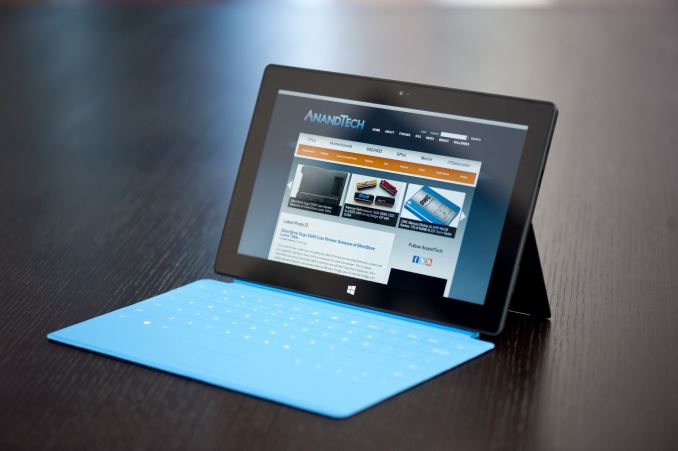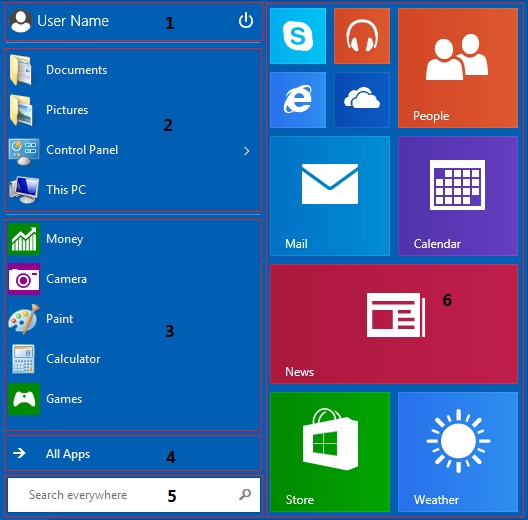Microsoft Quietly Rolls Out Windows RT Update To Enable Windows 10 Style Start Menu
by Brett Howse on September 16, 2015 6:10 PM EST- Posted in
- Operating Systems
- Microsoft
- Windows RT
- Windows 10

When Windows 10 was first announced, one of the first questions was would this upgrade be available for Windows RT devices running on ARM based platforms. The answer was no, but Microsoft said that it would bring some of the functionality of Windows 10 to Windows RT users though an update sometime after Windows 10 shipped. Apparently that day was yesterday, as Microsoft pushed out patch KB3033055 which enables the Windows 10 style Start Menu in Windows RT.
- Header. This is where the user account picture and power button appear.
- Pinned List. Apps that are pinned for easy access appear here.
- Most Frequently Used applications list (MFU). Apps that are frequently used but not pinned anywhere else will appear here.
- All Apps button. Selecting this button displays the All Apps list.
- Search text box. Typing here begins a search.
- App grid. Both Immersive and Win32 apps can be pinned, unpinned, and resized in this area.
For those with a Windows RT device, this update should come automatically through Windows Update. Since Windows RT is mainly on tablet style devices, the Start Menu may actually not be that useful, so you can enable or disable the Start Menu through the taskbar properties on the desktop.
It functions much like the Windows 10 style one, including pinning apps and such, but the actual design of it appears to be closer to what was available on older versions of Windows 10 during the preview period.
Windows 10 Start Menu in early preview is very similar
The other Windows 10 feature coming is circular frames for user account pictures. Unlike the Start Menu though, there is no method to enable or disable this, it is just going to be there.
Much like Windows Phone 7.8, Windows RT is now a dead platform and Microsoft has given it the smallest of upgrades to end its life. Since it is not running the Windows 10 kernel, Windows RT will never have access to the Windows 10 store, nor the Universal Windows App platform which launched with Windows 10. It instead will forever stay on the older WinRT framework which debuted with Windows 8.
I would have liked to include screenshots from my own Surface RT for this post, but it stopped working a couple of months ago, and clearly there is no need to replace it.
Source: Microsoft Support via ZDNet












19 Comments
View All Comments
Alexvrb - Wednesday, September 16, 2015 - link
They had universal apps prior to Win10. Heck the first one was Spartan Assault and that was two years ago. Obviously 10 uses a newer runtime, but is it not possible to compile something that can run on 8.1-based targets as well as 10-based runtimes?WorldWithoutMadness - Wednesday, September 16, 2015 - link
I think depends on how thing goes with the 3rd party developers, they might have a plan for a comeback, either in different form factory or low powered device only or actually they merged RT with mobile.It is funny how windows mobile get win10 but not RT while win10 mobile got continuum :D
cknobman - Friday, September 18, 2015 - link
I'm a windows developer.A. Universal apps have been around for several years
B. You do not even need to recompile to run windows 8 apps on windows 10. They are the same runtime and based on the same kernel. My windows phone app runs on windows phone 8.1 and windows 10 with zero modifications. My co developer has a windows app that runs on windows 8 and 10 and it needed no recompile changes or even a separate deployment.
That is what makes this windows store thing so cool. One build can work on multiple devices.
Alexvrb - Saturday, September 19, 2015 - link
See, that's what I always thought was the case. But then I figured OK maybe it was a superset or something.Anyway, that being the case, why is it that seemingly EVERY article on this seems to spell doom and gloom like WinRT 8.1 will no longer be able to run new/updated apps that are released to the Store? Is the Store getting segmented? WinRT uses the same runtime as 8.1, correct? So what's the big deal if it doesn't get updated, if it still does everything it always did plus run newer apps that didn't exist before.
Alexvrb - Wednesday, September 16, 2015 - link
Also, the only thing I think they should do for WinRT is backport Edge. I doubt they'll spent the resources, but that would be the only change I would say RT could really use.inighthawki - Wednesday, September 16, 2015 - link
IMO the version of IE on Windows RT was a much better tablet experience. Edge is pretty terrible regardless, too.Samus - Thursday, September 17, 2015 - link
That was where Windows RT made the most sense: you could use Internet Explorer and NOT worry about spyware, because no x86 program could launch, and the thing was so locked down you couldn't really run any programs not downloaded though the Windows Store.Unfortunately, RT was just terribly slow because let's face it, Tegra 3 and Tegra 4 are not very powerful "tablet" SoC's. Windows RT was very demanding of it and it always felt like an Atom experience, which was precisely what Microsoft was trying to avoid (because until Baytrail, Atom sucked)
Windows RT will go down as one of those many mistakes that cost Steve Ballmer his job. What a visionless clown.
Flunk - Thursday, September 17, 2015 - link
Windows RT would have existed even if they didn't put out any products using. They had to develop Windows for ARM to realize their dream of the Windows kernel on ARM phones and tablets. It was a stupid retail product, but a necessary step towards the One Windows vision.BMNify - Friday, September 18, 2015 - link
I will not call someone who made hundreds of Billions for Microsoft as Clown, Ballmer is worth $23 Billion and enjoying his retirement :)Alexvrb - Saturday, September 19, 2015 - link
If they backport Edge to WinRT, it would still retain that benefit. It's still locked down. Heck they could keep the same interface and just slip in the new rendering engine for all I care.